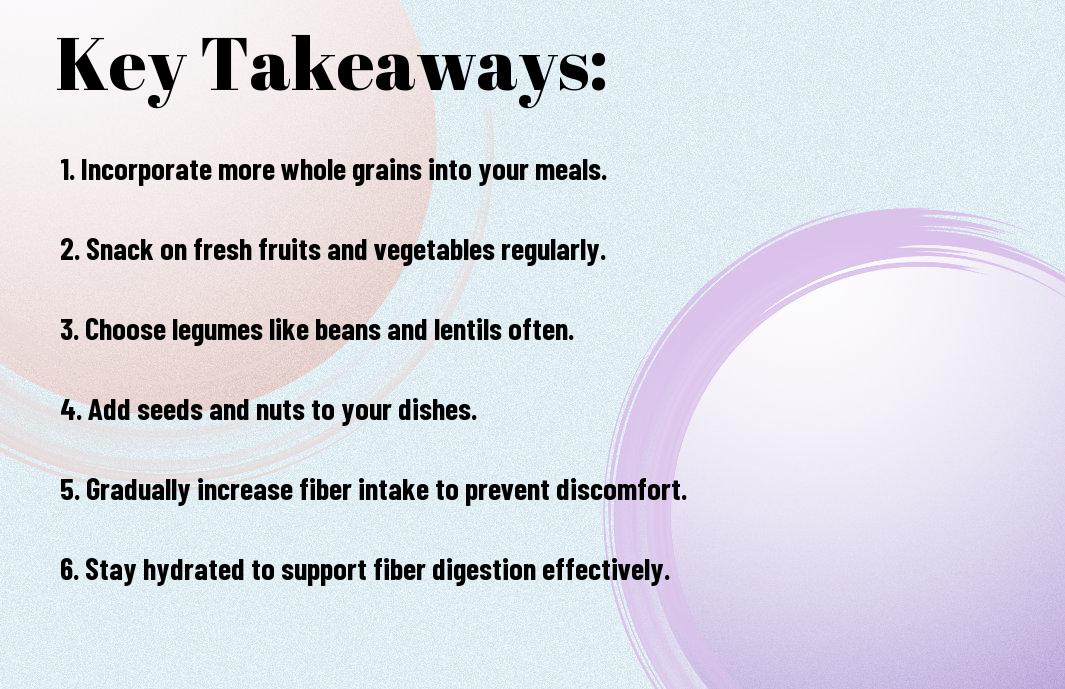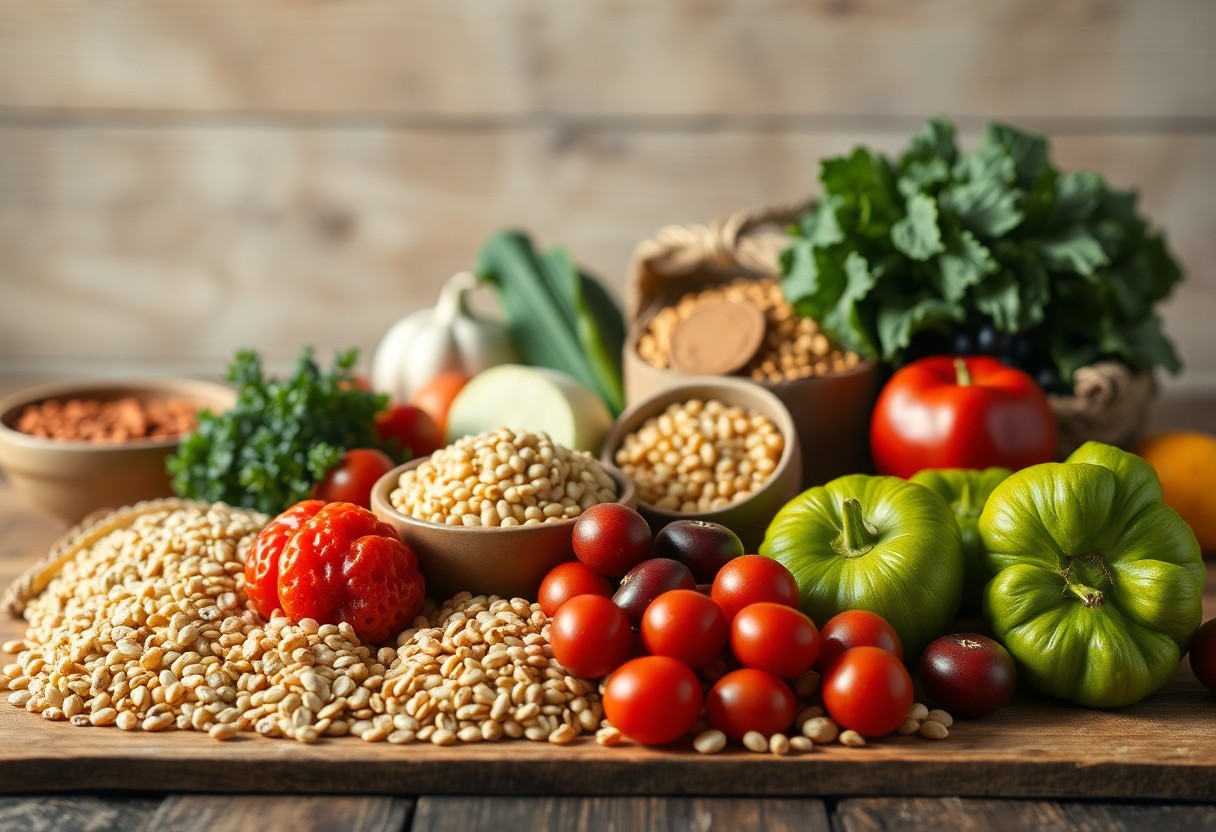Over the years, increasing your fiber intake has been linked to various health benefits, from better digestion to reduced risk of chronic diseases. By incorporating more fiber into your diet, you can not only improve your gut health but also maintain a steady weight and promote heart wellness. This post will guide you through simple strategies to boost your fiber consumption, making it easier to achieve the daily recommended intake without feeling deprived. Let’s explore how you can effortlessly enhance your meals with fiber-rich foods.
Key Takeaways:
- Incorporate more fruits and vegetables into your meals, aiming for a variety of colors and types to increase fiber intake.
- Choose whole grains instead of refined grains; opt for brown rice, whole-wheat bread, and oats to maximize fiber consumption.
- Snack on nuts, seeds, and legumes to add fiber-rich options to your diet, making it easier to meet daily fiber goals.
Understanding Fiber
While fiber is an crucial part of a healthy diet, many people struggle to consume enough of it. It is important to know that fiber helps regulate digestion and can lower cholesterol levels. To learn more effective ways to increase your fiber intake, check out 8 tips for reaching your daily fiber intake.
Types of Fiber
To understand fiber better, it helps to differentiate its two main types:
| Soluble Fiber | Absorbs water and forms a gel-like substance |
| Insoluble Fiber | Adds bulk to stool and aids in digestion |
| Sources | Fruits, vegetables, legumes, whole grains |
| Benefits | Helps manage weight and maintain blood sugar levels |
| Sources of Soluble Fiber | Oats, beans, nuts, and seeds |
Assume that incorporating both types into your diet will yield the most benefits.
Health Benefits of Fiber
Types of fiber offer numerous health benefits that enhance your overall well-being. A diet rich in fiber can help you maintain a healthy digestive system, promote satiety, and prevent overeating.
It also aids in regulating blood sugar levels, which is particularly beneficial for individuals with diabetes. Additionally, fiber has been linked to lower cholesterol levels and reduced risks of heart disease. By increasing your fiber intake, you empower your health and potentially ward off various chronic illnesses.

How Much Fiber Do You Need?
Some people may not realize that fiber needs vary from person to person. Generally, the recommended daily intake of fiber is around 25 grams for women and 38 grams for men. However, individual requirements depend on factors such as age, activity level, and overall health. Increasing your fiber gradually can lead to better digestive health and help you feel more satisfied throughout the day.
Recommended Daily Intake
After assessing your needs, it’s important to aim for the recommended daily intake of fiber. For most adults, this translates to approximately 25-30 grams per day. By focusing on whole foods rich in fiber, like fruits, vegetables, whole grains, and legumes, you can easily meet your goals and promote overall health.
Assessing Your Current Fiber Intake
Assessing your current fiber intake is the first step to making meaningful changes in your diet. Take some time to track what you eat for a few days, noting the fiber content in each item. This will help you identify which meals are lacking in fiber and areas where you can make improvements.
Much of your diet can impact your current fiber intake, as many processed foods tend to be low in this important nutrient. By becoming aware of your eating habits and the types of foods you consume, you can pinpoint gaps in your fiber consumption and explore ways to incorporate more fiber-rich options into your meals. Consider reading nutrition labels and utilizing online resources to keep track of your fiber intake effectively.
Best Sources of Dietary Fiber
Now that you understand the benefits of dietary fiber, discovering the best sources can help you boost your intake. Fiber-rich foods are vital for maintaining a healthy digestive system and overall well-being. Incorporating a variety of fiber-rich foods into your diet will not only enhance your meals but also contribute to your daily nutritional goals.
Fruits and Vegetables
Dietary fiber is abundant in fruits and vegetables, making them excellent choices for increasing your intake. Options like berries, apples, carrots, and broccoli are not only tasty but also packed with fiber. By adding these foods to your meals and snacks, you can enjoy their health benefits while keeping your fiber levels high.
Whole Grains
Along with fruits and vegetables, whole grains are a fantastic source of dietary fiber. Whole grain bread, brown rice, oats, and quinoa are just a few examples that can help you incorporate more fiber into your diet. Choosing whole grains over refined options ensures that you maximize your fiber intake, contributing to digestive health and satiety.
Another great aspect of whole grains is their versatility. You can use them in various dishes, from breakfast cereals to hearty grain salads. Swapping out white rice for brown rice or choosing whole grain pasta can make a significant difference in your fiber consumption without sacrificing flavor. It’s an easy change that can have lasting health benefits.
Legumes and Nuts
At the same time, legumes and nuts are excellent sources of fiber, offering both nutrition and crunch to your meals. Beans, lentils, chickpeas, almonds, and walnuts are packed with fiber and provide healthy fats, making them a great addition to your diet. Incorporating these foods can help you increase your fiber intake while enjoying a variety of flavors and textures.
Further enhancing your meals with legumes and nuts can also provide a satisfying source of protein. Consider adding chickpeas to salads, lentils to soups, or snacking on a handful of nuts for a quick energy boost. These foods not only help you meet your fiber goals but also contribute beneficial nutrients that support overall health.
Simple Strategies to Increase Fiber Intake
After identifying the importance of fiber, implementing simple strategies can help you boost your intake effectively. Start by incorporating more whole foods into your diet, such as fruits, vegetables, and whole grains. Gradually replace refined snacks with fiber-rich options like nuts and legumes. Cooking at home more often allows you to control ingredients, making it easier to add fiber into your meals seamlessly.
Meal Planning Tips
Across your weekly meals, plan for fiber-rich foods by creating a balanced menu. Include a variety of fruits, vegetables, and whole grains in your shopping list. Here are some helpful tips:
- Choose whole grain options for bread, pasta, and rice.
- Add beans or lentils into salads and soups.
- Incorporate vegetables into snacks, like carrots and hummus.
Knowing these practical tips can make all the difference in achieving your fiber intake goals.
Snacking Smarter
For many, snacking is a significant opportunity to increase fiber intake throughout the day. Choosing the right snacks can effortlessly incorporate more fiber into your diet, preventing hunger while promoting digestive health.
Smarter snacking revolves around selecting items that are not only satisfying but also packed with fiber. Opt for snacks like air-popped popcorn, mixed nuts, or fruit with nut butter. You can also explore vegetable sticks paired with hummus or whole grain crackers. By making these choices, you enhance your fiber intake while providing your body with imperative nutrients.
Incorporating Fiber into Your Diet
Your journey to a fiber-rich diet can start by making simple changes to your daily meals. Focus on adding whole grains, legumes, fruits, and vegetables into your menu. Consider trying new recipes that highlight fiber-dense ingredients, and choose snacks that are high in fiber, such as nuts and seeds. Gradually increasing your fiber intake can help your digestive system adjust, making it easier for you to enjoy the benefits of a fiber-rich lifestyle.
Breakfast Ideas
For a fiber-packed breakfast, start your day with options like oatmeal topped with fresh fruits and nuts or a smoothie made with spinach, banana, and chia seeds. You could also consider whole-grain toast with avocado or nut butter, as these options not only provide fiber but also important nutrients to fuel your morning.
Lunch and Dinner Solutions
By incorporating legumes such as beans or lentils into your salads or main dishes, you can easily boost your fiber intake. Consider preparing stir-fries with plenty of vegetables, whole-grain pasta, or brown rice. Additionally, aim to have at least one fiber-rich vegetable at each meal, like broccoli or Brussels sprouts.
Even simple swaps can make a significant difference; for example, using brown rice instead of white rice, or whole-grain bread instead of refined bread can elevate the fiber content of your meals. Roasting veggies to add to your dishes or preparing hearty soups with legumes can also enhance fiber levels. The key is to experiment with different fiber sources, ensuring your meals are satisfying and nutritious.

Common Challenges and Solutions
Unlike many quick fixes in diets, increasing fiber intake can come with challenges. You might experience digestive discomfort or find it difficult to incorporate enough fiber into your meals. To tackle these issues, identify the sources of fiber that work best for you and gradually adjust your diet. Choosing versatile fiber-rich foods and planning your meals can help you overcome these obstacles effectively.
Overcoming Digestive Issues
Among the most common concerns when increasing fiber intake are digestive issues such as bloating, gas, or constipation. To mitigate these problems, start by introducing fiber slowly into your diet. Also, ensure you are drinking enough water to aid digestion and promote regular bowel movements. Keeping a balanced fiber intake will help your digestive system adjust more comfortably.
Staying Consistent with Fiber Intake
Staying consistent with your fiber intake can be a challenge, especially if you’re adjusting to new eating habits. To maintain a steady intake, plan your meals ahead and include a variety of fiber sources, such as whole grains, fruits, and vegetables, in your grocery list. This will ensure you always have high-fiber options available.
Also, consider incorporating fiber-rich snacks into your daily routine, such as nuts, seeds, or whole grain crackers. This can help bridge the gap between meals while keeping your fiber intake consistent. Setting reminders for meal prep and making shopping lists can simplify your efforts. By establishing these habits, you can enjoy the benefits of a fiber-rich diet with ease.
Final Words
Summing up, increasing your fiber intake can significantly improve your digestive health and overall well-being. You can achieve this by incorporating more whole grains, fruits, vegetables, legumes, and nuts into your meals. Consider making simple changes, such as opting for whole grain bread, snacking on raw fruits and veggies, or adding beans to salads. Gradually boost your fiber intake to allow your digestive system to adjust, and don’t forget to drink plenty of water to help manage the increased fiber. By making these dietary adjustments, you will foster better health and vitality.
FAQ
Q: Why is fiber important for my diet?
A: Fiber plays a significant role in digestive health, helping to regulate bowel movements and prevent constipation. Additionally, it can aid in weight management by promoting a feeling of fullness and may help lower cholesterol and blood sugar levels. Consuming adequate fiber can contribute to overall health and well-being.
Q: What are some high-fiber foods I can include in my meals?
A: Numerous foods are rich in fiber. Good options include fruits like berries, apples, and pears; vegetables such as broccoli, carrots, and leafy greens; whole grains like oats, quinoa, and brown rice; legumes such as beans, lentils, and chickpeas; and nuts and seeds. Incorporating a variety of these foods into your diet can help increase your fiber intake.
Q: How can I gradually increase my fiber intake?
A: It’s best to increase fiber intake gradually to give your digestive system time to adjust. Start by adding one additional serving of a high-fiber food each day, and then slowly incorporate more over time. For example, you might begin with a small bowl of fruits for breakfast or a side of vegetables at lunch. Make sure to increase your water intake as well, as fiber works best with adequate hydration.
Q: Are there any easy ways to boost fiber intake while cooking?
A: Yes, you can easily increase fiber content in meals by making simple substitutions. For instance, swap white rice for brown rice or quinoa, use whole grain pasta instead of regular pasta, and add legumes to soups, salads, or stews. You can also enhance smoothies with the addition of fruits, vegetables, or ground flaxseeds for extra fiber.
Q: Can I get enough fiber from supplements?
A: While fiber supplements can help, it’s generally best to obtain fiber from whole foods as they provide additional nutrients, vitamins, and minerals that supplements lack. If considering a supplement, consult a healthcare professional to ensure it aligns with your dietary needs and goals. Whole foods are typically more beneficial for overall health.



